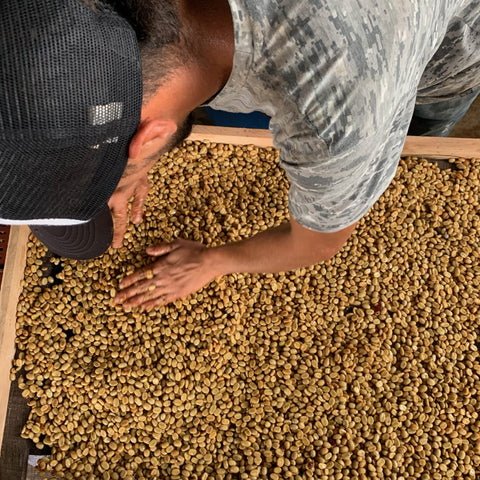Why do we need a scale when brewing coffee?
Let’s begin with a question! If you wanted to make your favourite cake, would you follow a recipe? Most of you reading this, would more than likely answer yes. What would happen if you didn’t follow the recipe? It’s probably going to result in a disappointing taste. The same applies when we make coffee. When it comes to making a good brew, precision is key.
To achieve this precision, you need a barista scales (we give you a few suggestions below!). In this blog, we’re going to be sharing some of the ways and reasons why you should be using a scale when brewing coffee.
WEIGHT

This is one of the most important reasons for using a scale. You can’t just eyeball the amount of beans you use, and here’s why:
Different types of coffee beans have different densities; altitude is one of the main factors that affects the density of coffee beans. At higher altitudes coffee cherries mature and ripen more slowly, resulting in beans that are more dense. Denser beans also contain higher levels of sugar, resulting in more complex and sweeter cup profiles – which is why they are more desirable. The cherries mature for longer because higher altitudes typically offer consistently cool temperatures all year round. This is important, as the arabica plant grows optimally at temperatures between 18 and 21°C (64 and 69°F). Outside of this range, the fruit will mature too quickly. But altitude and temperature are not the only factors that play a role in bean density. Variety, rainfall, and even nutrient distribution all have a part to play.
Put simply; twenty beans of a more dense coffee may weigh completely different to twenty beans of another. If you’re looking to repeatedly produce great tasting coffee, then you’ll want a scale to ensure precision in weight.
WATER RATIO

Your scales can also be used to measure out the amount of water you brew so you’re brewing consistently each time. The amount of coffee to water ratio is one of the biggest factors when making coffee and the most commonly accepted coffee to water ration for brewing is 1:16 (16 times the amount of water to coffee). By using a scales, you are able to tweak and perfect this ratio. You may even want to experiment and play around with different combinations as this will alter the taste and taste is all about personal preference. Coffee aficionados will accept ratios between 1:15 and 1:18.
CONSISTENCY IS KEY
If you’re feeling frustrated because you’re using the ‘same’ amount of coffee each time you scoop a couple of spoonful’s of ground coffee into your cafetiere and expecting the same flavourful brew as the day before, this is because you’re not weighing your coffee. Choosing to use a scales will mean no more guessing at coffee scoops and water usage means no more “off” coffee days. You know exactly how much coffee and water you’re using. You’re confident that it’ll be rich and balanced every day.
If elements are changed, e.g., origin of coffee (in other words, beans), this will produce varied weights and may produce a different grind size. The same applies to changing your grinder, different grinders may produce different results.
So, instead of relying on that scoop to measure out your coffee, the scales will keep your coffee consistent each time, allowing you to have the best tasting coffee experience.
TIME IS OF THE ESSENCE
A great brew relies on timing to get it just the way you like it. If you are brewing your coffee using a cafetiere, you may want to replicate the same brew time in which you leave your coffee to steep. The same applies to the pour over method, measuring the total brew time helps establish a baseline. It’s difficult to extract everything you want to out of a pour over brew in less than two-and-a-half minutes. At the same time, if the brew is dragging on past five minutes, it’s likely to start pulling in those astringent flavours. Most pour over brewing has a sweet spot right around three to four minutes, and if you establish a consistent brew time, you can then rely on grind size as your main variable. When it comes to making espresso, time is the least important variable in the coffee making process. However, to bring out the sweetness and complexity of a coffee you need to allow enough contact time to extract the flavour. If you were to dose 18g of coffee and have a 36g yield but the coffee is extracting within 10 seconds, it is probably going to be very sour. It is recommended for you to reach a recommended extraction time of 25-30 seconds for a well-extracted espresso shot. However, this doesn’t apply to every coffee, and each coffee has its’ own unique recipe.
In conclusion, as we said earlier, the preferred taste of your coffee is personal to you and a lot of the time, you’ll need to experiment and tweak the recipe to achieve the most flavourful brew. By experimenting using scales and creating recipes, you’ll be able to replicate your favourite brew! Here’s a list of barista scales (priced from low-high) that we recommend you use!
Tiamo Digital Scale with Timer
£49
https://youbarista.co.uk/collections/coffee-scales/products/tiamo-digital-scale-with-timer
Timemore Black Mirror Coffee Scales
£50
https://youbarista.co.uk/collections/coffee-scales/products/timemore-black-mirror-coffee-scales
Acaia Pearl 2.0 Coffee Scale
£185
https://youbarista.co.uk/collections/coffee-scales/products/acaia-pearl-2021-coffee-scales
Acaia Lunar 2021 Espresso Coffee Scale
£285
https://youbarista.co.uk/collections/coffee-scales/products/acaia-lunar-espresso-coffee-scale
